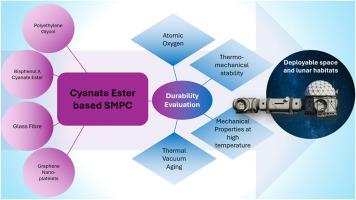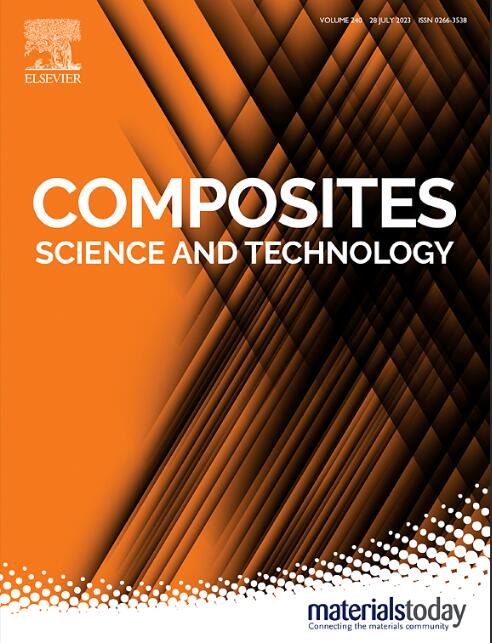Effect of atomic oxygen and vacuum thermal aging on graphene and glass fibre reinforced cyanate ester-based shape memory polymer composite for deployable thin wall structures
IF 8.3
1区 材料科学
Q1 MATERIALS SCIENCE, COMPOSITES
引用次数: 0
Abstract
Deployable components and structures are a crucial part of space exploration. Due to fewer parts, low weight and cost, shape memory polymers (SMPs) and their composites (SMPCs) are considered ideal candidates for this. However, lower thermal stability and poor durability in the space environment have limited their applicability. This research work details the development of Graphene Nanoplatelets (GNP) filled Glass Fibre (GF) reinforced cyanate ester-based SMPC with 0/90° and ±45° sandwich fibre lay-up configuration capable of multidirectional shape programming. The SMP matrix was synthesised by mixing Cyanate Ester and Polyethylene Glycol (PEG) with added GNP. SMPC was fabricated by pouring the SMP mixture into a pre-prepared glass mould with the added GF layers. The synthesised SMPC showed shape programming and recovery at 169.01 ± 0.62 °C and stable thermomechanical properties at the temperature of 130 °C. Durability tests at extreme environmental conditions including Atomic Oxygen exposure, thermal vacuum aging, and elevated-temperature behaviour tests were conducted as these tests evaluate the durability and applicability of the SMPC for use in Earth's orbits and lunar environments. The performances of the samples before and after durability tests were measured through mechanical tests, shape memory effect tests and a series of characterisation methods such as microscopic image analysis, FTIR and dynamic mechanical analysis. According to the results, AO exposure affected the SMPCs by eroding their surface. There were no changes in the chemical structure of the SMPC yet the thermomechanical, mechanical and shape memory properties were decreased without compromising their safe operational levels such as storage onset temperatures (128.79 ± 3.08 °C), maximum tensile stress (114.99 ± 21.52 MPa), shape fixity (100 %) and recovery ratios (100 %). The erosion resistance of the GNP-filled SMPCs was improved with ∼54.35 % less erosion than the SMPC without GNP. The vacuum thermal aging slightly slowed shape recovery from 31.17 % to 8.32 % at 160 °C due to PEG crosslink degradation, however, 100 % shape recovery was achieved at the end. Further durability tests under cryogenic temperatures and effects after vacuum thermal cycles are warranted to observe the synergistic effect on the SMPC for future developments. Exploring the scalability and additive manufacturability of the developed SMPC can be advantageous in the future while mitigating challenges such as complex shape programming, long-term materials degradation, resource efficiency and compliance with safety standards.

原子氧和真空热老化对用于可部署薄壁结构的石墨烯和玻璃纤维增强型氰酸酯基形状记忆聚合物复合材料的影响
可部署组件和结构是太空探索的重要组成部分。由于部件少、重量轻、成本低,形状记忆聚合物(SMP)及其复合材料(SMPC)被认为是理想的候选材料。然而,在太空环境中较低的热稳定性和较差的耐久性限制了它们的适用性。本研究工作详细介绍了石墨烯纳米片(GNP)填充玻璃纤维(GF)增强型氰酸酯基 SMPC 的开发情况,其 0/90° 和 ±45° 夹层纤维铺层配置能够进行多向形状编程。SMP 基质是通过混合氰酸酯和聚乙二醇(PEG)以及添加的 GNP 合成的。将 SMP 混合物倒入预先准备好的玻璃模具中,再加入 GF 层,就制成了 SMPC。合成的 SMPC 在 169.01 ± 0.62 °C 的温度下显示出形状编程和恢复,在 130 °C 的温度下显示出稳定的热机械性能。在极端环境条件下进行了耐久性测试,包括原子氧暴露、热真空老化和高温行为测试,这些测试评估了 SMPC 在地球轨道和月球环境中使用的耐久性和适用性。通过机械测试、形状记忆效应测试以及显微图像分析、傅立叶变换红外光谱和动态机械分析等一系列表征方法,测量了耐久性测试前后样品的性能。结果表明,AO 暴露对 SMPC 的影响是侵蚀其表面。虽然 SMPC 的化学结构没有发生变化,但其热力学、机械和形状记忆特性却有所下降,而且不会影响其安全操作水平,如储存起始温度(128.79 ± 3.08 °C)、最大拉伸应力(114.99 ± 21.52 兆帕)、形状固定性(100 %)和恢复率(100 %)。填充了 GNP 的 SMPC 的抗侵蚀性得到了改善,侵蚀程度比未填充 GNP 的 SMPC 降低了 ∼54.35 %。由于 PEG 交联降解,真空热老化略微减缓了形状恢复速度,在 160 °C 时形状恢复率从 31.17% 降至 8.32%,但最终形状恢复率达到了 100%。有必要对低温条件下的耐久性和真空热循环后的效果进行进一步测试,以观察对 SMPC 的协同效应,促进未来的开发。探索所开发的 SMPC 的可扩展性和可添加制造性在未来会很有优势,同时还能缓解复杂的形状编程、长期材料降解、资源效率和符合安全标准等挑战。
本文章由计算机程序翻译,如有差异,请以英文原文为准。
求助全文
约1分钟内获得全文
求助全文
来源期刊

Composites Science and Technology
工程技术-材料科学:复合
CiteScore
16.20
自引率
9.90%
发文量
611
审稿时长
33 days
期刊介绍:
Composites Science and Technology publishes refereed original articles on the fundamental and applied science of engineering composites. The focus of this journal is on polymeric matrix composites with reinforcements/fillers ranging from nano- to macro-scale. CSTE encourages manuscripts reporting unique, innovative contributions to the physics, chemistry, materials science and applied mechanics aspects of advanced composites.
Besides traditional fiber reinforced composites, novel composites with significant potential for engineering applications are encouraged.
 求助内容:
求助内容: 应助结果提醒方式:
应助结果提醒方式:


